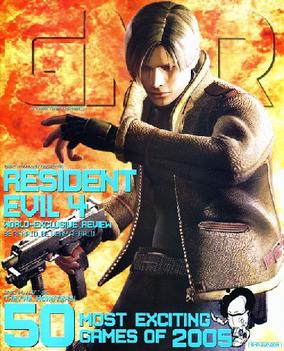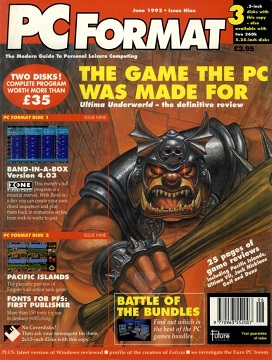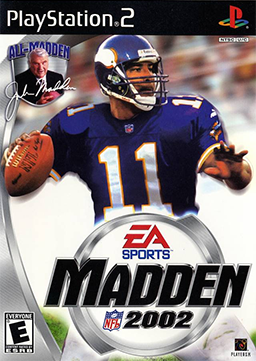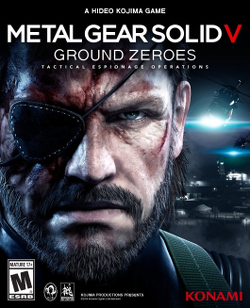History
GameNOW's roots began in July 1994 [1] when the popular magazine Electronic Gaming Monthly launched a spin-off magazine called EGM2 . EGM² was essentially "another EGM," only without a reviews section and a greater emphasis on import games.
Starting in August 1998, EGM² became Expert Gamer (often abbreviated to XG), and the magazine's focus shifted away from news and previews to strategy and tricks. Despite the different name, XG continued EGM²'s numbering system. XG lasted for 39 issues until October 2001 (with the last issue being XG #88).
The next month (November 2001), XG was replaced by GameNOW. Although GameNOW maintained a healthy tricks section and occasional strategy guides, the magazine's focus shifted to in-depth previews and reviews. Targeted to a younger audience than that of EGM (16 year-olds, while also appealing to 10-15 year-olds), GameNOW concentrated less on industry insider-type features and more on the actual video games, including numerous large screenshots and elaborate feature articles.
In November 2002 (issue #13), the GameNOW staff was almost completely replaced when Ziff-Davis moved its video game magazines from the Chicago suburb of Oak Brook, Illinois to San Francisco, California. Of the original staff, only two writers made the move to California. Shortly after the move, the magazine underwent a massive redesign.
April Fools
It's a tradition among Ziff-Davis' video game magazines (particularly Electronic Gaming Monthly), to plant an April Fools joke in the April issue. During its brief history, GameNOW only had one April Fool's joke.
In issue #6 (April 2002), on page 42, there was a one-page preview for an Xbox game called Metal Gear Solid X. Before Metal Gear Solid 2: Substance was announced for either PlayStation 2 or Xbox, GameNOW ran this preview for the fake game. MGSX was said to be an Xbox port of the PlayStation 2 game, Metal Gear Solid 2: Sons of Liberty . The biggest selling point of this game was that after playing through the game once, a bonus mode was unlocked, allowing a play through the game again as the series' main hero, Solid Snake, instead of MGS2's hero, Raiden.
Additionally, extra features in the Solid Snake mode included the return of Nastasha Romanenko (from the original Metal Gear Solid ), a boss fight against Revolver Ocelot, the chance to assist Raiden in battles from the first play-through (this time from Snake's point of view), and access to previously locked areas of Big Shell.
The preview featured seven very convincing (yet phony) screenshots of the new features. The two screenshots that show Snake wandering through a red office building were photographs of the GameNOW offices that had their colors altered and the Metal Gear characters inserted into them. In the first-person screenshot that shows Snake in a helicopter shooting down at a Harrier jet, the hand holding the gun belongs to Mike Vallas, the man who created the fake screens.

Metal Gear Solid is an action-adventure stealth video game developed and published by Konami for the PlayStation in 1998. It was directed, produced, and written by Hideo Kojima, and follows the MSX2 video games Metal Gear and Metal Gear 2: Solid Snake, which Kojima also worked on. It was unveiled at the 1996 Tokyo Game Show and then demonstrated at trade shows including the 1997 Electronic Entertainment Expo; its Japanese release was originally planned for late 1997, before being delayed to 1998.
Metal Gear is a franchise of stealth games created by Hideo Kojima. Developed and published by Konami, the first game, Metal Gear, was released in 1987 for MSX home computers. The player often takes control of a special forces operative, who is assigned the task of finding the titular superweapon, "Metal Gear", a bipedal walking tank with the ability to launch nuclear weapons.

Metal Gear Solid 2: Sons of Liberty is a 2001 action-adventure stealth video game developed by Konami Computer Entertainment Japan and published by Konami for the PlayStation 2. Originally released on November 13, 2001, it is the fourth Metal Gear game produced by Hideo Kojima, the seventh overall game in the series and is a sequel to Metal Gear Solid (1998). An expanded edition, titled Metal Gear Solid 2: Substance, was released the following year for Xbox and Windows in addition to the PlayStation 2. A remastered version of the game, Metal Gear Solid 2: Sons of Liberty - HD Edition, was later included in the Metal Gear Solid HD Collection for the PlayStation 3, Xbox 360, and PlayStation Vita. The HD Edition of the game was included in the Metal Gear Solid: Master Collection Vol. 1 compilation for Nintendo Switch, PlayStation 4, PlayStation 5, Windows, and Xbox Series X/S, which was released on October 24, 2023.

Metal Gear Solid 3: Snake Eater is a 2004 action-adventure stealth video game developed and published by Konami for the PlayStation 2. It was released in late 2004 in North America and Japan, and in early 2005 in Europe and Australia. It was the fifth Metal Gear game written and directed by Hideo Kojima and serves as a prequel to the entire Metal Gear series. An expanded edition, titled Metal Gear Solid 3: Subsistence, was released in Japan in late 2005, then in North America, Europe and Australia in 2006. A remastered version of the game, Metal Gear Solid 3: Snake Eater - HD Edition, was later included in the Metal Gear Solid HD Collection for the PlayStation 3, Xbox 360, and PlayStation Vita, while a reworked version, titled Metal Gear Solid: Snake Eater 3D, was released for the Nintendo 3DS in 2012. The HD Edition of the game was included on the Metal Gear Solid: Master Collection Vol. 1 compilation for Nintendo Switch, PlayStation 4, PlayStation 5, Windows, and Xbox Series X/S on October 24, 2023. The same year, Konami announced a remake, entitled Metal Gear Solid Delta: Snake Eater, set to release for PlayStation 5, Windows, and Xbox Series X/S in 2024.

Electronic Gaming Monthly (EGM) is a monthly American video game magazine. It offers video game news, coverage of industry events, interviews with gaming figures, editorial content and product reviews.

GMR was a monthly magazine on video games that was published by Ziff-Davis — the publisher of such magazines as PC Magazine, Electronic Gaming Monthly, and Computer Gaming World. GMR was launched in February 2003, being sold in only the Electronics Boutique (EB) chain of video game stores. The magazine was unusual among multiconsole magazines in that it covered PC as well as console games, as well as its minimalistic cover art, and, in its last few months, its shift in focus toward promotion of less mainstream titles. It lasted exactly two years, as the 25th and last issue was the February 2005 edition.

PC Format was a computer magazine published in the United Kingdom by Future plc, and licensed to other publishers in countries around the world. In publication between 1991 and 2015, it was part of Future plc's Format series of magazines that include articles about games, entertainment and how to get the most out of the platform. Despite the occasional mention of alternatives, PC Format takes the term 'PC' to mean a Microsoft Windows-based computer.

GamePro was an American multiplatform video game magazine media company that published online and print content covering the video game industry, video game hardware and video game software. The magazine featured content on various video game consoles, personal computers and mobile devices. GamePro Media properties included GamePro magazine and their website. The company was also a part subsidiary of the privately held International Data Group (IDG), a media, events and research technology group. The magazine and its parent publication printing the magazine went defunct in 2011, but is outlasted by Gamepro.com.

Metal Gear Solid 4: Guns of the Patriots is a 2008 action-adventure stealth video game developed by Kojima Productions and published by Konami for the PlayStation 3. It is the sixth Metal Gear game directed by Hideo Kojima. Set five years after the events of Metal Gear Solid 2: Sons of Liberty, the story centers around a prematurely aged Solid Snake, now known as Old Snake, as he goes on one last mission to assassinate his nemesis Liquid Snake, who now inhabits the body of his former henchman Revolver Ocelot under the guise of Liquid Ocelot, before he takes control of the Sons of the Patriots, an A.I. system that controls the activities of PMCs worldwide. The game was released on June 12, 2008.

Madden NFL 2002 is an American football video game. It features former Minnesota Vikings quarterback Daunte Culpepper on the cover. Pat Summerall and John Madden are the commentators. The Madden NFL 2002 commercial first aired during Super Bowl XXXVI, three days after Madden NFL 2002 started selling in Japan. Notably, it does not feature the Super Bowl MVP Tom Brady, who is included on later editions of the game as a roster update. It is also the first game to be developed by Budcat Creations.

1Up.com was an American entertainment website that focused on video games. Launched in 2003, 1Up.com provided its own original features, news stories, game reviews, and video interviews, and also featured comprehensive PC-focused content. Like a print magazine, 1Up.com also hosted special week-long online cover stories that presented each day a new in-depth feature story, interview with the developers, game screenshot gallery, game video footage, and video of the game studio and creators. On February 21, 2013, Ziff Davis announced it would be winding down the site, along with sister sites GameSpy and UGO.com.

Official Xbox Magazine was a British monthly video game magazine which started in November 2001 around the launch of the original Xbox. A preview issue was released at E3 2001, with another preview issue in November 2001. The magazine was bundled with a disc that included game demos, preview videos and trailers, and other content, such as game or Xbox updates and free gamerpics. The discs also provided the software for the Xbox 360 for backward compatibility of original Xbox games for those without broadband and Xbox Live access. From January 2012, OXM no longer included a demo disc. In mid-2014, the U.S. version was merged into the UK version on the website, which lasted only a few months until Future plc announced that it was closing its website along with all the other websites that Future has published, including Edge and Computer and Video Games. In February 2015, OXM and all of Future's video game websites were redirected into GamesRadar.

GamesTM was a UK-based, multi-format video games magazine, covering console, handheld, PC and Arcade games. The first issue was released in December 2002 and the magazine was still being published monthly in English and German up until the last edition was published on 1 November 2018.
Expert Gamer was a United States-based video game magazine that was published by Ziff Davis from August 1998 to October 2001. There are 39 issues of Expert Gamer in total. The bulk of XG's content was video game strategy guides and cheat codes. There were no reviews and only occasional light-hearted features.

PlayStation Official Magazine – UK, generally abbreviated as OPM, was a magazine based in the United Kingdom that covered PlayStation news created in 2006. Although the first issue was distributed in three-month intervals, from Issue 2 onward, it became a monthly segment. From Issue 7 to Issue 84, the magazine came with a playable Blu-ray disc; it primarily covered PlayStation 4, PlayStation 4 Pro, PlayStation VR and PlayStation 5 games and material. It also covered PlayStation Vita material. The magazine covered PlayStation, as well as all aspects of HD media in lesser detail.

FirstPlay was a video gaming online magazine published by Future Publishing for Sony Computer Entertainment Europe. It was produced by the team behind PlayStation Official Magazine and features video reviews and previews and screenshots of upcoming and recently released PlayStation 3 games. Episodes were released weekly on the PlayStation Store where users could choose to purchase a single episode or a 90-day subscription at a discounted rate.

Metal Gear is an action-adventure stealth video game developed and published by Konami for the MSX2. It was released for the system in Japan and parts of Europe in 1987. Considered the game to popularize the stealth game genre, it was the first video game to be fully developed by Hideo Kojima, who would go on to direct most of the games in the Metal Gear series. A reworked port of the game was released for the Famicom a few months later, which later saw release in international markets for the NES over the following two years; this version was developed without Kojima's involvement and features drastically altered level designs, among other changes. An emulated Famicom version came with the special edition of Metal Gear Solid: The Twin Snakes on GameCube. A more faithful port of the MSX2 version was later included in Metal Gear Solid 3: Subsistence for the PlayStation 2, as well as in the HD Edition of the same game released for the PlayStation 3, Xbox 360 and PlayStation Vita, with these newer ports featuring a revised translation and additional gameplay features. The MSX version was also released for Wii Virtual Console and PC.

Metal Gear Solid HD Collection is a compilation of remastered ports of Metal Gear video games released for PlayStation 3 and Xbox 360 in 2011 and PlayStation Vita in 2012. The compilation contains Metal Gear Solid 2: Sons of Liberty and Metal Gear Solid 3: Snake Eater on all three platforms, plus Metal Gear Solid: Peace Walker on the home console versions, with the individual games all branded as HD Edition. Bluepoint Games handled the conversions of Metal Gear Solid 2 and 3, while Genki worked on Peace Walker.

Metal Gear Solid V: The Phantom Pain is a 2015 action-adventure stealth video game developed by Kojima Productions and published by Konami. Directed, written, and designed by Hideo Kojima, it is the ninth installment in the Metal Gear franchise, following Metal Gear Solid V: Ground Zeroes, a stand-alone prologue released the previous year. Set in 1984, nine years after the events of Ground Zeroes, the story follows mercenary leader Punished "Venom" Snake as he ventures into Soviet-occupied Afghanistan and the Angola–Zaire border region to exact revenge on those who destroyed his forces and came close to killing him during the climax of Ground Zeroes.

Metal Gear Solid V: Ground Zeroes is a 2014 action-adventure stealth video game developed by Kojima Productions and published by Konami. It is the eighth game in the Metal Gear series directed, written and designed by Hideo Kojima, and serves as a prologue to Metal Gear Solid V: The Phantom Pain, released the following year. Set in 1975, a few months after the events of Metal Gear Solid: Peace Walker, the story follows Snake as he infiltrates an American black site in Cuba called Camp Omega, attempting to rescue Cipher agent Paz Ortega Andrade and former Sandinista child soldier Ricardo "Chico" Valenciano Libre.


















